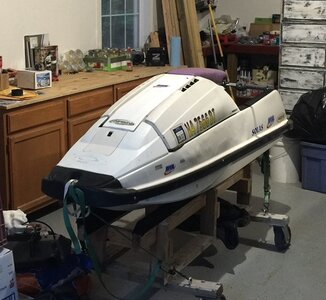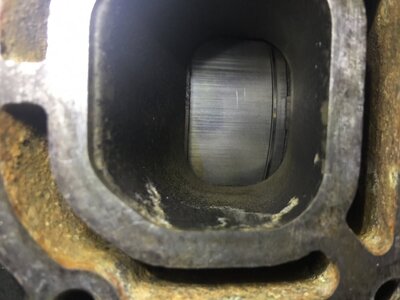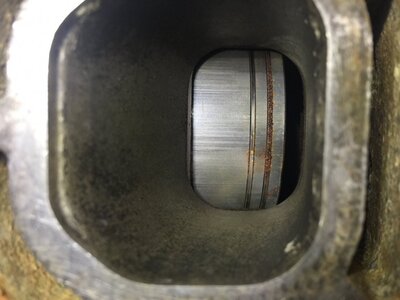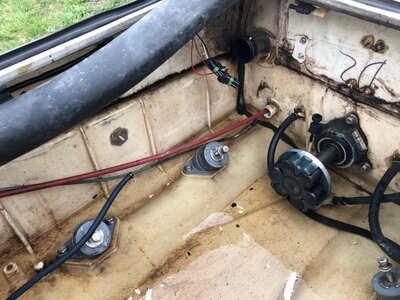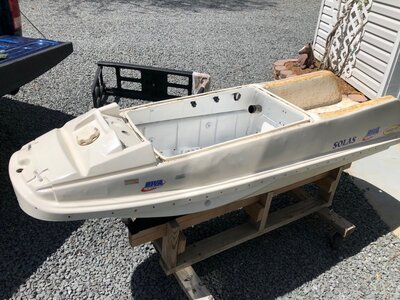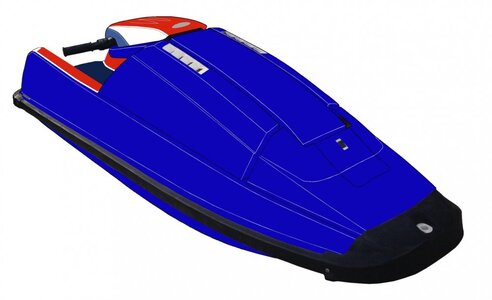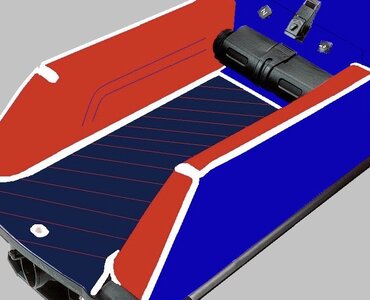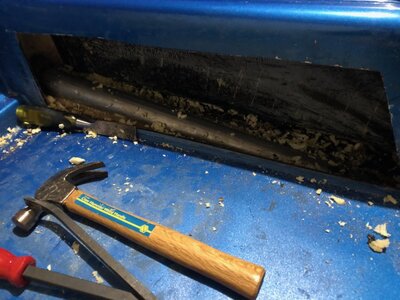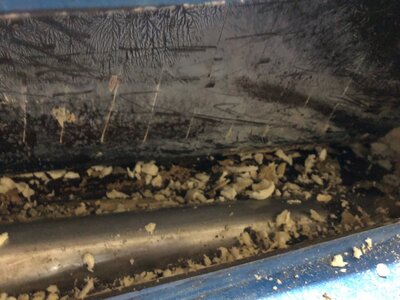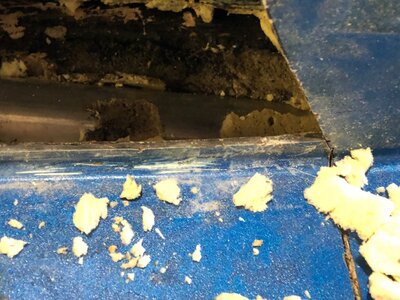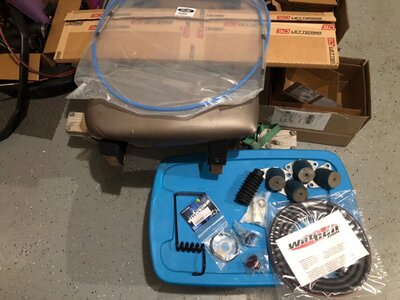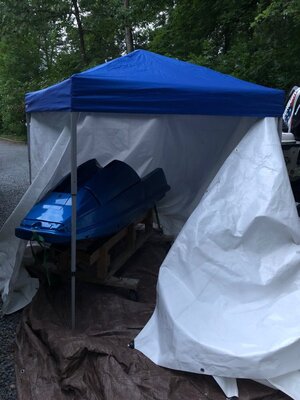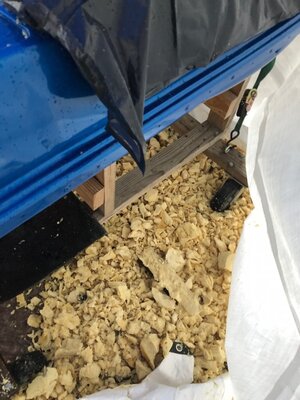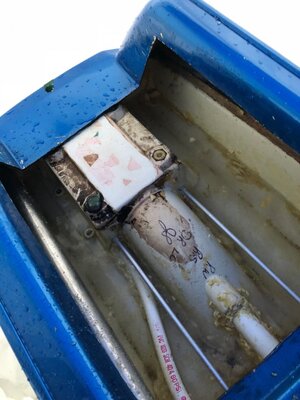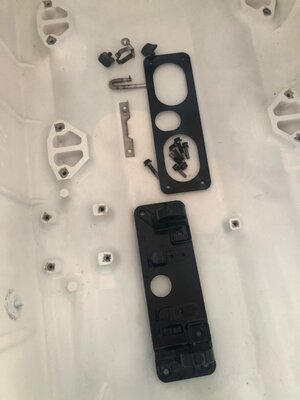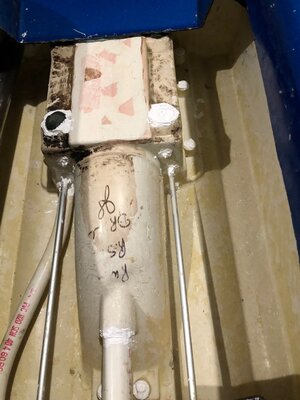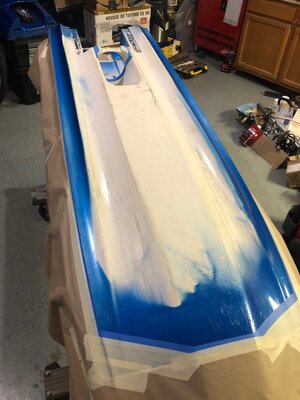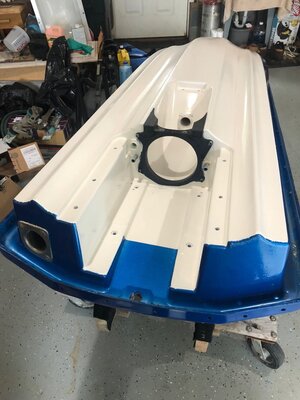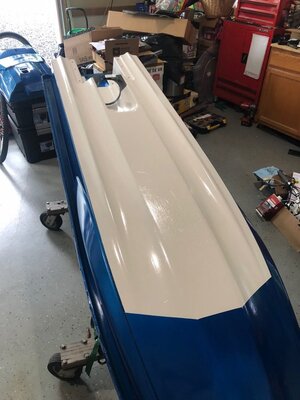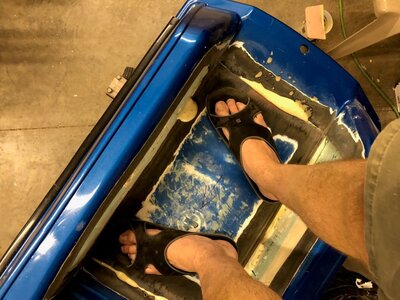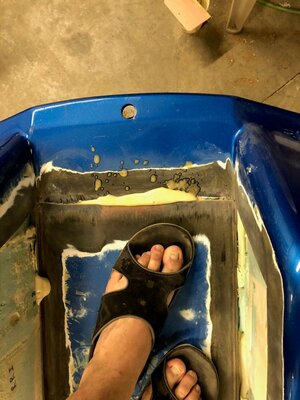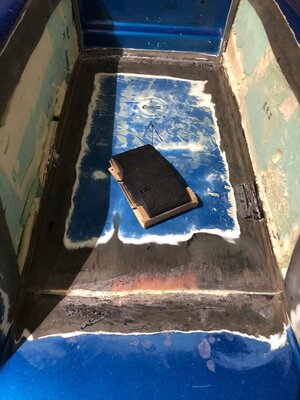June 13-14: Foam time! So we (keep in mind Craig is going through much of the same things with one of his SN) got a closed cell foam insulation sheet and some 2-part expanding foam. The plan was to mainly fill the cavity with pieces of block, and fill it in fully with the expanding foam. I spent a good bit of time cutting up foam block to fill in this messy puzzle.
FYI - If you want the convenience of a reciprocating saw but don't want the 2-handed burden of a sawzall, check out something like this:
https://www.milwaukeetool.com/Products/Power-Tools/SAWZALL-Reciprocating-Saws/HACKZALLS/2719-20. Was VERY nice having this to cut the foam like butter. The 1-handed design also made it easy to shave off corners and such to make everything fit snug in the gunwales. Good for quick pruning jobs too.


You can see where I drilled holes in various places to try and get the foam down into all the crevices. There are even more in the lower blocks you can't see. Several smaller pieces were stuck in every gap that could reasonably hold them. A lot of planning went into laying all this in there to use as much block as possible.

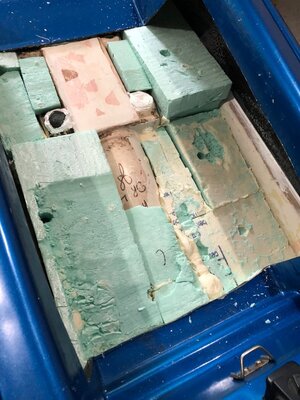
So the mixed foam was much thicker than anticipated. The 1/2" holes didn't pass it as well as expected, so remaining holes were widened more. The foam also starts thickening further and expanding VERY quickly. I realized that I was going to have to do more smaller pours between and around blocks to properly fill the gaps. Also instead of trying to fill spaces through the holes, I had to estimate the required amount, pour the foam, and place the blocks and pour more over/around them as needed. It felt like trying to build a brick wall with expanding mortar, but the wall can't go outside of certain dimensions. After a little waste and some cursing, I got it figured out. Jeff happened to witness much of this, and decided he would rather burn a ski than go through all this. I might agree with him at first, but I think I would be better able to knock this out in the future. Here's to hoping I never have to find out!
So some words on expanding foam:
1- Watch someone on Youtube first so you're not going in blind.
2- Read the can fully. Understand your available mixing/working time, temperature effects, etc.
3- Not much surface prep required
4- Wear gloves! I used some cheap latex or nitrile coated fabric gloves, and they worked well and cleaned off easy enough after it hardened. Disposable gloves could work too. It's messy and sticky stuff, and you will definitely get it on you.
4- It starts to expand and increase viscosity very quickly. IIRC you may have 20-30 seconds from the time the two parts first make contact before you can visibly see the difference. After 45-60 seconds, whatever's left in the container isn't pouring out. Pour the thicker fluid in the container first, then the thinner one when you're ready to start mixing, and mix quickly while adding it. You must get the ratios right and the parts fully mixed or the expansion won't be right. I highly recommend a power mixer, like for paint, and not mixing sticks. If you're trying to pour between and around parts vs. into a bigger void, then the quick change will affect you more. Expansion will continue for 5+ minutes, though slower over time, and it will be hard after 10-15 minutes.
5- Make sure you have everything laid out before mixing each batch. You don't have any time to fix it once you start mixing. You'll either have an undesirable pour, or a wasted batch. Helps to have a second person to help pour the 2 parts, place blocks, etc.
6- Make the first batch small. You'll mix it quicker and have more time to figure it out. If you goof it, it's less waste (stuff ain't cheap). You also get to see the expansion effect before continuing. It expands a considerable amount, so go easy at first. It also doesn't care what it's pushing against, it will build up a lot of pressure and lift or push things out of its way. Be ready with a lot of weight if needed for your application to try and minimize lifting.
7- To minimize time between batches, have a way to keep foam from hardening on your mixing tool, unless you're using a box of wooden mixing sticks (which I don't recommend due to the time that takes compared to the quantity you need to mix). I used a paint mixer on a drill, which worked well. I had a large glass jar with 1-2" of acetone in the bottom next to my mixing tub, spaced perfectly from the cabinet so the drill could lean against it and the tip rested in the acetone. After mixing, I immediately ran the mixer in the acetone 1-2 seconds to wash it off, and let it sit there while I got to pouring, as every second matters! Worked perfectly. Having someone else to help handle this while you pour may also be helpful.
8- Have more than one mixing container. I used 2 plastic pint tubs. After a pour, I could use the second one while the residue in the first hardened. It was then easily removed with a screwdriver or chisel and ready for more. Can't remember if the can said to avoid paper tubs or not. Pretty sure no to metal though.
9- Not having properly marked measuring devices to commit to this, I used two clear plastic cups. I made multiple marks on one that could be used for different sized batches, then carefully made matching marks on the other (mine was 1:1 mix). The material will remove any marks inside the cup, so no red Solo cups (for the foam)!
10- It changes a lot as it expands. It gets pretty hot, more than epoxy. A larger pour will make the hull feel pretty warm quickly. I don't believe batch size effects the expansion/cure rate near as much as with epoxy. At first it's quite liquidy, then quickly gets sticky as it expands. After a couple minutes it skins over, but is still sticky. At this point the expansion is pretty much done. It also cools quicker than epoxy. Once the skin is no longer sticky (though you can still press into the curing foam somewhat easily), expansion is definitely done. It should start feeling cooler at this point, and is fun to poke and play with. If you have any blobs sticking out that you want to remove, now is the time to easily pull or pry them off without messing up the whole job. If you wait, they will be fully hardened and have to be cut off or sanded down.
11- It sands very easily. 60-80 grit on an orbital sander will make very quick work of it, but a mess too. The block foam was a little slower, but still fairly simple. Larger chunks can also be removed with a handheld hack saw blade (gloves recommended).
In hindsight, I realized I spent way too long trying to get all the block foam in the way I did. This would've been good if only using block, but not also with expanding foam. I should've just got the larger spaces mostly filled with large block pieces, then just used a little more liquid foam to fill it in. This is what we did with Craig's ski eventually, and it went much smoother. If we were to do it again, both us us would use all expanding foam. If doing that, use lower density foam (2-4#) to save on weight and $$. If doing smaller areas (ie footholds) then definitely go with 2# foam. If I had to do this on a tighter budget, I would do more block, like I did, with a lighter foam as the filler. I think Craig got heavier (6#?) foam for us when I did mine first, then 4# when he got more to finish the second half of his. When done, the tray was a bit heavier than I was expecting. I'll try and get a weight later before reassembly.
EDIT: After discussing this with someone who deals with foam professionally, you definitely don't need heavier than 2# foam for something like this. They can lift buildings with 2# expanding foam, and only use 4# for tougher jobs. 6# would be way overkill!!

To do the gunwales, I simply flopped the ski onto its side on the stand. It stood stable enough and could be rolled around (rails 12" O.C.). You can see here some of the blobs I mentioned above. This is really neat stuff, but a pain to figure out when you first start to use it. I had to pour a little extra in around the top and rear part of this cavity, then jam the block in behind it and let it expand to fill the void. You know it expanded enough when you feel the heat through the hull in all areas. Don't want it to break when I'm riding around standing on the top rails! Speaking of which, anyone have a good idea of how much of the strength comes from the body when new, and how much comes from the foam?

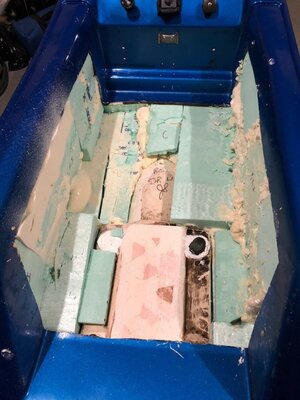
As you can see in several pictures, one of the original glue chunks between the tray layers on top of the pump bolts stayed in place. It was nice having that there as a reference point to how high I needed to build up my foam.

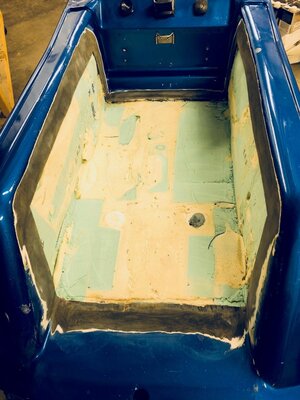
Pretty much done with foam, ready to get the tray back together. Just grab some glass and be done, right?

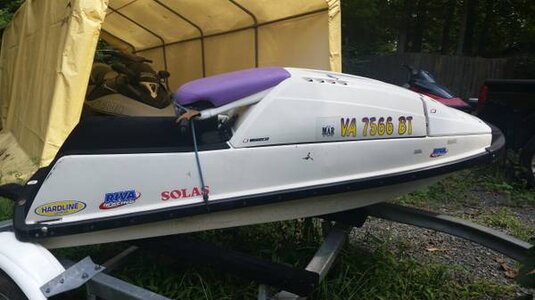
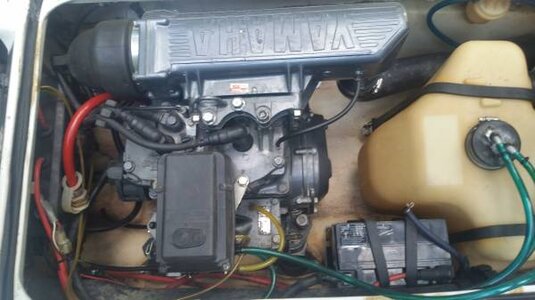
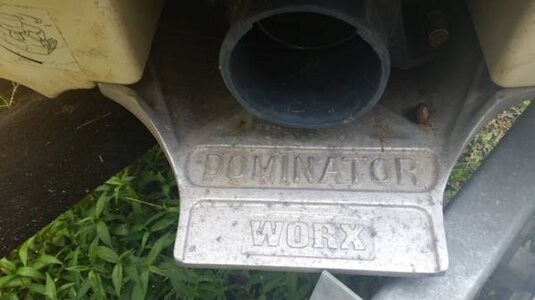

 (http://x-h2o.com/index.php?threads/backwards-sponsons.175585) Oh well, it still handled much better in the corners and more stable straight at speed. Too bad I put so much 5200 on when I installed them.
(http://x-h2o.com/index.php?threads/backwards-sponsons.175585) Oh well, it still handled much better in the corners and more stable straight at speed. Too bad I put so much 5200 on when I installed them.